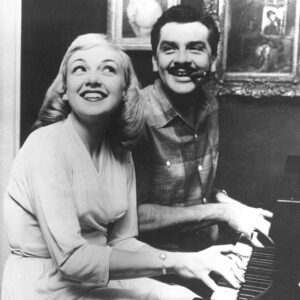This is an encore of a Musings I posted here in January of 2018, which was exactly as described … my Memories of Ernie. To it, I’m now including some additional biographical information. If interested, at the bottom you’ll find links which will provide a very full picture of this unique, very whimsical entertaining individual … still to this day one of my “heroes,” as he chose to live life his way. As I have learned, doing so can bring some negative consequences … but you can survive and make a positive difference along the way! If you can use your talents to bring some joy, maybe a few laughs, to others–go for it!
If you ever traveled north toward New York City on the Pennsylvania Railroad, now Amtrak, from Pennsylvania or further south, as you crossed the Delaware River into Trenton (pronounced Tren-Ton), New Jersey, you surely have noticed this sign on the adjacent bridge, which carries vehicular traffic between Morrisville, Pennsylvania and Trenton.
This slogan was adopted more than 100 years ago, as the city had become a leader in manufacturing a wide variety of goods, and was the home to such firms as the Roebling Company, which manufactured wire rope, and whose namesakes, father and son, were behind the building of the famed Brooklyn Bridge in New York, as well as several other great suspension bridges across the nation.
Another “product” to come out of Trenton in the 1940s was the one-and-only Ernie Kovacs, who was being heard on Trenton’s WTTM (World Takes what Trenton Makes, reversed due to structure requirements of U. S. radio station call letters; however, this was the original version of the slogan). I first began listening to him in the latter part of the 1940s after receiving my own radio following World War Two … I can assure you, there was never a dull moment.
Throughout this era, WTTM always had a broadcast booth at the New Jersey State Fair, from which much of the local programming originated during the Fair’s annual eight-day run. I became a true fan of Ernie’s when, in the Fall of 1949, he allegedly did eight straight days of broadcasting without sleeping, Sunday through Sunday, from that booth. I said “allegedly” as, while many hours were filled with DJ time, WTTM was an NBC affiliate … allowing him––as engineer friends confirmed––to take catnaps during the network’s daytime and evening blocks.
Before continuing, let me share some of his early life … which it’s almost amazing that he survived:
Ernie had enjoyed a pampered childhood and developed an early interest in theater, playing his first roles in plays presented in his elementary school. Demonstrating his acting talents through high school, his drama teacher at Trenton Central High School (the same school my dear wife Alicia would graduate from, albeit 15 years later) would help him secure a scholarship at the New York’s American Academy of Dramatic Arts. However, once in New York, he had no money and at times, subsisted on nothing more than bread and water.
Eventually, his health began to fail and one night while performing in Vermont, he finally collapsed, suffering from pleurisy and pneumonia. Somehow surviving, he spent well over a year in two sanatoriums until well enough to escape and return to the footlights. After a variety of performances with groups over a couple of years––none producing any real income––come 1942, he landed an audition and was hired by Trenton’s brand new radio station, WTTM … an affiliation which would last ‘til the end of the decade. Come 1945 and the end of World War Two … Ernie would add two things to his life but, to me, neither would truly be positive additions to his life––he became a columnist for the city’s new tabloid newspaper, the Trentonian … he got married!
It wasn’t long after his week-long experience at the New Jersey State Fair that Ernie was becoming too big for Trenton and radio, especially since he was killing himself working too hard and earning barely enough money to survive. Early in 1950, the opportunity for doing a daytime television show on WPTZ in Philadelphia presented itself. This I never saw, as we did not yet own a TV set. However, I did have exposure to nighttime shows, thanks to two neighbors with sets where I was invited to go a couple of evenings a week.
Then, in November 1950, WPTZ decided to pioneer early morning television and gave Ernie the opportunity to “do his thing”– 90 minutes of insanity, which later expanded to two hours. Now I was feeling TV-deprived … not being able to see some of Ernie in action. Early in 1951, I contracted scarlet fever or some kind of malady, which kept me out of school for a good month. Mt parents finally relented and one afternoon my stepfather brought home a 14” Admiral set.
How much of what happened on the show had been planned in Ernie’s head, I don’t know if anyone ever knew. However, for most of the cast and crew, it was be ready for whatever might be coming next. One situation that became a constant … Ernie would not be in the studio at the show’s beginning. Then, a camera would look out of the studio’s 3rd floor window and finally see Ernie a block or two up Walnut Street chatting with someone or simply seeking some mischief as he “wandered toward work.” This was freeform, ad lib television that was live and alive (just like radio, where many of us would love to occasionally turn the clock back a few decades and re-live the “good old days”).
While some bios report otherwise, my first memory of Ernie’s theme song, “Oriental Blues,” was played by the Eddie Hatrak Trio – in fact, at one time I had a 45 RPM record of their performance. Eddie was a pianist trained at the Julliard School in New York and became a well-respected pianist and piano teacher in the Trenton area. Ernie and Eddie had attended Trenton High School together in the 1930’s. I don’t know if Eddie worked with Ernie at all prior to his TV days (although it was reported that Eddie was Music Director at WTTM in the 1940’s), but when Ernie headed to Philadelphia and began his TV years, Eddie would eventually join Ernie’s “cast” and was his music director for at least some of Ernie’s New York TV shows.
If you’ve never heard “Oriental Blues,” here’s a recording of it. There’s no indication of who the artist is on this performance … it’s similar to Eddie Hatrak’s playing, but doesn’t sound quite like him.
Before going on, let me not forget “The Early Eyeball Fraternal & Marching Society,” one of Ernie’s morning show gimmicks … and it had a membership card. Of course, I had to be a member and have a card.
Due to NBC’s launch of the Today show in the 7 to 9 AM time slot and Philadelphia being such a prime market, network executives demanded that Channel 3 carry it … so Ernie’s Three To Get Ready would last less than two years … but what a blast those two years were!
Ernie’s first exposure on national nighttime television came as a summer replacement show at 7 PM weeknights on NBC during July and August of 1951. This was what I remember as the first appearance of Edie Adams with Ernie … the network demanding that the show have a singer. Edie had been crowned Miss U. S. Television of 1950, a beauty contest aired on WATV Channel 13 in Newark, New Jersey. According to a printed article I read at the time, a producer of Ernie’s show had seen her performing in an Atlantic City club. Here’s a photo of Ernie and Edie together during one of those shows, courtesy the archives of WPTZ/KYW-TV Channel 3 Philadelphia.
Spurred on by the creative mind of Ernie, those around him worked to develop techniques that were truly innovative and pace-setting for television of that period; things that in today’s world of digital are not even thought of as being unique … such as devising the “split-screen” view and a Channel 3 engineer who used a soup can and two mirrors to reverse the image on the screen, creating the illusion that Ernie was walking on the ceiling.
Following the end of the morning show, the way was opened for Ernie to head to New York. There he did network and local shows for CBS, DuMont and ABC for several years before heading to Hollywood. Edie and Ernie eloped to Mexico and married in 1954. And Marlin’s life moved into a new chapter, which did not provide many opportunities for watching Ernie’s shows.
If you’d like to read more about Ernie’s life from birth through to his untimely death in 1962, you’ll find a pretty complete biography here at Wikipedia For a detailed look at his years in Philadelphia TV, here’s a Link to his page on the Broadcast Pioneers of Philadelphia website. And, while I take issue with a few of the stated facts, there’s a fairly complete biography of Ernie’s life in a book by David G. Walley titled the “Ernie Kovacs Phile” — it’s available from Amazon.
Now, let us leave you with the same message Ernie closed each show with:
“It’s Been Real!”




It is a shame Ernie died before technical effects such as running video tape backwards was developed. I remember watching “I’ve Got A Secret” when Edie Adams introduced the effect along with Chuck McCann who first used it on the children’s shows I watched at the time. Through the magic of YouTube I can recall that program:
https://www.youtube.com/watch?v=pJnr_FhbR4Y
Recall some of the later shows and of course have seen clips on retrospectives. Entertaining. As a young pianist I had to learn to play his theme because I would get many requests for it. Many years later I realized it had a marked similarity to Gershwin's rag Rialto Ripples published in 1917. His debts rather cast a pall over his legacy in the immediate years following his death.